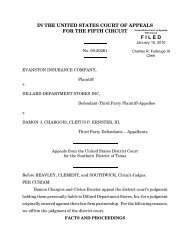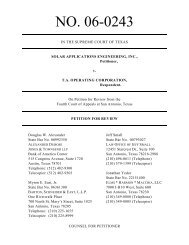Laughlin v. Nouveau Body & Tan - The Appellate Record
Laughlin v. Nouveau Body & Tan - The Appellate Record
Laughlin v. Nouveau Body & Tan - The Appellate Record
Create successful ePaper yourself
Turn your PDF publications into a flip-book with our unique Google optimized e-Paper software.
Case: 09-10622 Document: 00511064454 Page: 4 Date Filed: 03/29/2010No. 09-10622In an oral ruling, the bankruptcy court determined that, following Drye v.United States, 528 U.S. 49 (1999), <strong>Laughlin</strong>’s renunciation of his interest in hisfather’s estate was a fraudulent transfer under § 727(a)(2). Specifically, thebankruptcy court concluded that <strong>Laughlin</strong> “had the power to channel [hisinheritance interest]” and he thus transferred that interest by renouncing hisinheritance; that <strong>Laughlin</strong> had the intent to delay, hinder, or defraud hiscreditors when he made the transfer; and that <strong>Laughlin</strong>’s intent in transferring2this interest was sufficient to deny discharge under § 727(a)(2).<strong>Laughlin</strong> appealed the denial of his discharge under § 727(a)(2). <strong>The</strong>district court determined that the bankruptcy court had not erred in making itsfactual findings, agreed with the bankruptcy court that “federal law applies indefining ‘transfer’ and ‘property’” under § 727(a)(2), and concluded that thebankruptcy court appropriately denied discharge under § 727(a)(2). <strong>Laughlin</strong>timely appealed to this court.II. DISCUSSIONA. Standard of Review2<strong>The</strong> bankruptcy court made this determination despite finding that <strong>Laughlin</strong>’s intentto transfer his interest in his father’s estate to his mother was “credible.” <strong>The</strong> bankruptcycourt reasoned that because <strong>Laughlin</strong>’s inheritance interest included a significant number ofshares of LPI and because <strong>Laughlin</strong> controlled LPI and was manipulating it to reduce itsexposure to creditors (by, inter alia, changing his and his wife’s salaries), <strong>Laughlin</strong> hadrenounced his interest in his father’s estate with the intent to hinder and delay <strong>Nouveau</strong>. <strong>The</strong>bankruptcy court reviewed indicators of fraud and found that <strong>Laughlin</strong> received noconsideration for his renunciation, that the “transfer” was made to a family member, that<strong>Laughlin</strong> did not retain control or use of the property after its transfer, that <strong>Laughlin</strong> was inbad financial shape at the time of the renunciation, that <strong>Laughlin</strong> had not been credible in histestimony generally, and that the pattern and general chronology of the events suggestedfraud. On this point, the court recounted how <strong>Laughlin</strong> had manipulated LPI and his role inthe company, and that <strong>Laughlin</strong> had taken these actions shortly following the judgmentsentered in favor of <strong>Nouveau</strong>. <strong>The</strong> court also referenced Louisiana case law and noted that itwould be “difficult” and costly for <strong>Nouveau</strong> to petition the Louisiana state courts to undo<strong>Laughlin</strong>’s renunciation and that this also suggested that <strong>Laughlin</strong> transferred property withthe intent to hinder, delay, or defraud his creditors.4




